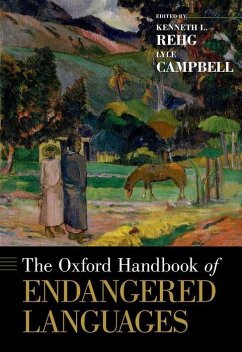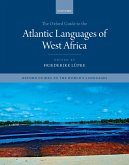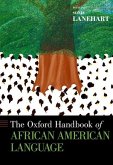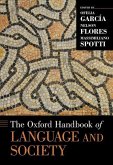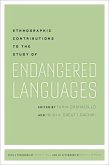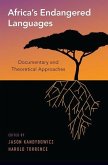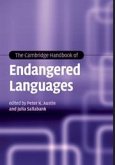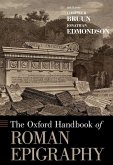Oxford Handbook of Endangered Languages
Herausgeber: Rehg, Kenneth L; Campbell, Lyle
Oxford Handbook of Endangered Languages
Herausgeber: Rehg, Kenneth L; Campbell, Lyle
- Gebundenes Buch
- Merkliste
- Auf die Merkliste
- Bewerten Bewerten
- Teilen
- Produkt teilen
- Produkterinnerung
- Produkterinnerung
The Oxford Handbook of Endangered Languages, in 39 chapters, is a comprehensive resource on endangered languages. It broadens understanding of language endangerment, language documentation, and language revitalization, and in doing so encourages further research and support for endangered languages.
Andere Kunden interessierten sich auch für
![The Oxford Guide to the Atlantic Languages of West Africa The Oxford Guide to the Atlantic Languages of West Africa]() The Oxford Guide to the Atlantic Languages of West Africa219,99 €
The Oxford Guide to the Atlantic Languages of West Africa219,99 €![The Oxford Handbook of African American Language The Oxford Handbook of African American Language]() The Oxford Handbook of African American Language269,99 €
The Oxford Handbook of African American Language269,99 €![The Oxford Handbook of Language and Society The Oxford Handbook of Language and Society]() The Oxford Handbook of Language and Society236,99 €
The Oxford Handbook of Language and Society236,99 €![Ethnographic Contributions to the Study of Endangered Languages Ethnographic Contributions to the Study of Endangered Languages]() Ethnographic Contributions to the Study of Endangered Languages72,99 €
Ethnographic Contributions to the Study of Endangered Languages72,99 €![Africa's Endangered Languages Africa's Endangered Languages]() Africa's Endangered Languages196,99 €
Africa's Endangered Languages196,99 €![The Cambridge Handbook of Endangered Languages The Cambridge Handbook of Endangered Languages]() The Cambridge Handbook of Endangered Languages199,99 €
The Cambridge Handbook of Endangered Languages199,99 €![Oxford Handbook of Roman Epigraphy Oxford Handbook of Roman Epigraphy]() Christer BruunOxford Handbook of Roman Epigraphy270,99 €
Christer BruunOxford Handbook of Roman Epigraphy270,99 €-
-
-
The Oxford Handbook of Endangered Languages, in 39 chapters, is a comprehensive resource on endangered languages. It broadens understanding of language endangerment, language documentation, and language revitalization, and in doing so encourages further research and support for endangered languages.
Hinweis: Dieser Artikel kann nur an eine deutsche Lieferadresse ausgeliefert werden.
Hinweis: Dieser Artikel kann nur an eine deutsche Lieferadresse ausgeliefert werden.
Produktdetails
- Produktdetails
- Verlag: Oxford University Press
- Seitenzahl: 976
- Erscheinungstermin: 15. August 2018
- Englisch
- Abmessung: 254mm x 178mm x 61mm
- Gewicht: 1760g
- ISBN-13: 9780190610029
- ISBN-10: 0190610026
- Artikelnr.: 50760818
- Herstellerkennzeichnung
- Libri GmbH
- Europaallee 1
- 36244 Bad Hersfeld
- gpsr@libri.de
- Verlag: Oxford University Press
- Seitenzahl: 976
- Erscheinungstermin: 15. August 2018
- Englisch
- Abmessung: 254mm x 178mm x 61mm
- Gewicht: 1760g
- ISBN-13: 9780190610029
- ISBN-10: 0190610026
- Artikelnr.: 50760818
- Herstellerkennzeichnung
- Libri GmbH
- Europaallee 1
- 36244 Bad Hersfeld
- gpsr@libri.de
Kenneth L. Rehg is an Associate Professor of Linguistics at the University of Hawai'i at Mânoa (retired) and an authority on the languages of Micronesia. He is the (co)author of three books and numerous papers on these languages and the founding editor of Language Documentation & Conservation. His interests include language documentation, lexicography, phonology, historical linguistics, and the application of linguistics to the formation of educational policies and practices in the developing nations of the Pacific. Lyle Campbell is Emeritus Professor of Linguistics at the University of Hawai'i at Mânoa. He has held joint appointments in Linguistics, Anthropology, Behavioral Research, Latin American Studies, and Spanish, and has been a Visiting Professor in Australia, Brazil, Canada, Finland, Germany, Mexico, New Zealand, and Spain. His interests include language documentation, historical linguistics, indigenous languages of the Americas, and typology.
* Foreword
* Michael Krauss
* Introduction
* Lyle Campbell and Kenneth L. Rehg
* Part I: Endangered Languages
* (1) The status of the world's endangered languages
* Anna Belew and Sean Simpson
* (2) Assessing degrees of language endangerment
* Nala H. Lee and John R. Van Way
* (3) Language contact and language endangerment
* Sarah G. Thomason
* (4) Indigenous language rights-miner's canary or mariner's tern?
* Teresa L. McCarty
* Part II: Language Documentation
* (5) The goals of language documentation
* Richard Rhodes and Lyle Campbell
* (6) Documentation, linguistic typology, and formal grammar
* Keren Rice
* (7) The design and implementation of documentation projects for
spoken languages
* Shobhana Chelliah
* (8) Endangered sign languages: An introduction
* James Woodward
* (9) Design and implementation of collaborative language documentation
projects
* Racquel-María Sapién
* (10) Tools and technology for language documentation and
revitalization
* Keren Rice and Nick Thieberger
* (11) Corpus compilation and exploitation in language documentation
projects
* Ulrike Mosel
* (12) Writing grammars of endangered languages
* Amber Camp, Lyle Campbell, Victoria Chen, Nala H. Lee, Matthew
Lou-Magnuson, and Samantha Rarrick
* (13) Compiling dictionaries of endangered languages
* Kenneth L. Rehg
* (14) Orthography design and implementation for endangered languages
* Michael Cahill
* (15) Language archiving
* Andrea L. Berez-Kroeker and Ryan E. Henke
* (16) Tools from the ethnography of communication for language
documentation
* Simeon Floyd
* (17) Language documentation in diaspora communities
* Daniel Kaufman and Ross Perlin
* (18) Ethics in language documentation and revitalization
* Jeff Good
* Part III: Language Revitalization
* (19) Approaches to and strategies for language revitalization
* Leanne Hinton
* (20) Comparative analysis in language revitalization practices:
addressing the challenge
* Gabriela Pérez Báez, Rachel Vogel, and Eve Okura Koller
* (21) The linguistics of language revitalization: Problems of
acquisition and attrition
* William O'Grady
* (22) New media for endangered languages
* Laura Buszard-Welcher
* (23) Language recovery paradigms
* Alan R. King
* (24) Myaamiaataweenki: Revitalization of a sleeping language
* Daryl Baldwin and David J. Costa
* (25) Language revitalization in kindergarten: A case study of Truku
Seediq language immersion
* Apay Tang
* (26) Mâori: Revitalisation of an endangered language
* Jeanette King
* (27) Language revitalization in Africa
* Bonny Sands
* (28) Planning minority language maintenance: challenges and
limitations
* Sue Wright
* Part IV: Endangered Languages and Biocultural Diversity
* (29) Congruence between species and language diversity
* David Harmon and Jonathan Loh
* (30) Sustaining biocultural diversity
* Luisa Maffi
* (31) Traditional and local knowledge systems as language legacies
critical for conservation
* Will C. McClatchey
* (32) Climate change and its consequences for cultural and language
endangerment
* Christopher P. Dunn
* (33) Interdisciplinary language documentation
* Gary Holton
* (34) Why lexical loss and culture death endanger science
* Ian Mackenzie and Wade Davis
* Part V: Looking to the Future
* (35) Funding the documentation and revitalization of endangered
languages
* Susan Penfield
* (36) Teaching linguists to document endangered languages
* Carol Genetti
* (37) Training language activists to support endangered languages
* Nora C. England
* (38) Designing mobile applications for endangered languages
* Steven Bird
* (39) Indigenous language use impacts wellness
* Alice Taff, Melvatha Chee, Jaeci Hall, Millie Yéi Dulitseen Hall,
Kawenniyóhstha Nicole Martin, Annie Johnston
* Afterword
* David Crystal
* Michael Krauss
* Introduction
* Lyle Campbell and Kenneth L. Rehg
* Part I: Endangered Languages
* (1) The status of the world's endangered languages
* Anna Belew and Sean Simpson
* (2) Assessing degrees of language endangerment
* Nala H. Lee and John R. Van Way
* (3) Language contact and language endangerment
* Sarah G. Thomason
* (4) Indigenous language rights-miner's canary or mariner's tern?
* Teresa L. McCarty
* Part II: Language Documentation
* (5) The goals of language documentation
* Richard Rhodes and Lyle Campbell
* (6) Documentation, linguistic typology, and formal grammar
* Keren Rice
* (7) The design and implementation of documentation projects for
spoken languages
* Shobhana Chelliah
* (8) Endangered sign languages: An introduction
* James Woodward
* (9) Design and implementation of collaborative language documentation
projects
* Racquel-María Sapién
* (10) Tools and technology for language documentation and
revitalization
* Keren Rice and Nick Thieberger
* (11) Corpus compilation and exploitation in language documentation
projects
* Ulrike Mosel
* (12) Writing grammars of endangered languages
* Amber Camp, Lyle Campbell, Victoria Chen, Nala H. Lee, Matthew
Lou-Magnuson, and Samantha Rarrick
* (13) Compiling dictionaries of endangered languages
* Kenneth L. Rehg
* (14) Orthography design and implementation for endangered languages
* Michael Cahill
* (15) Language archiving
* Andrea L. Berez-Kroeker and Ryan E. Henke
* (16) Tools from the ethnography of communication for language
documentation
* Simeon Floyd
* (17) Language documentation in diaspora communities
* Daniel Kaufman and Ross Perlin
* (18) Ethics in language documentation and revitalization
* Jeff Good
* Part III: Language Revitalization
* (19) Approaches to and strategies for language revitalization
* Leanne Hinton
* (20) Comparative analysis in language revitalization practices:
addressing the challenge
* Gabriela Pérez Báez, Rachel Vogel, and Eve Okura Koller
* (21) The linguistics of language revitalization: Problems of
acquisition and attrition
* William O'Grady
* (22) New media for endangered languages
* Laura Buszard-Welcher
* (23) Language recovery paradigms
* Alan R. King
* (24) Myaamiaataweenki: Revitalization of a sleeping language
* Daryl Baldwin and David J. Costa
* (25) Language revitalization in kindergarten: A case study of Truku
Seediq language immersion
* Apay Tang
* (26) Mâori: Revitalisation of an endangered language
* Jeanette King
* (27) Language revitalization in Africa
* Bonny Sands
* (28) Planning minority language maintenance: challenges and
limitations
* Sue Wright
* Part IV: Endangered Languages and Biocultural Diversity
* (29) Congruence between species and language diversity
* David Harmon and Jonathan Loh
* (30) Sustaining biocultural diversity
* Luisa Maffi
* (31) Traditional and local knowledge systems as language legacies
critical for conservation
* Will C. McClatchey
* (32) Climate change and its consequences for cultural and language
endangerment
* Christopher P. Dunn
* (33) Interdisciplinary language documentation
* Gary Holton
* (34) Why lexical loss and culture death endanger science
* Ian Mackenzie and Wade Davis
* Part V: Looking to the Future
* (35) Funding the documentation and revitalization of endangered
languages
* Susan Penfield
* (36) Teaching linguists to document endangered languages
* Carol Genetti
* (37) Training language activists to support endangered languages
* Nora C. England
* (38) Designing mobile applications for endangered languages
* Steven Bird
* (39) Indigenous language use impacts wellness
* Alice Taff, Melvatha Chee, Jaeci Hall, Millie Yéi Dulitseen Hall,
Kawenniyóhstha Nicole Martin, Annie Johnston
* Afterword
* David Crystal
* Foreword
* Michael Krauss
* Introduction
* Lyle Campbell and Kenneth L. Rehg
* Part I: Endangered Languages
* (1) The status of the world's endangered languages
* Anna Belew and Sean Simpson
* (2) Assessing degrees of language endangerment
* Nala H. Lee and John R. Van Way
* (3) Language contact and language endangerment
* Sarah G. Thomason
* (4) Indigenous language rights-miner's canary or mariner's tern?
* Teresa L. McCarty
* Part II: Language Documentation
* (5) The goals of language documentation
* Richard Rhodes and Lyle Campbell
* (6) Documentation, linguistic typology, and formal grammar
* Keren Rice
* (7) The design and implementation of documentation projects for
spoken languages
* Shobhana Chelliah
* (8) Endangered sign languages: An introduction
* James Woodward
* (9) Design and implementation of collaborative language documentation
projects
* Racquel-María Sapién
* (10) Tools and technology for language documentation and
revitalization
* Keren Rice and Nick Thieberger
* (11) Corpus compilation and exploitation in language documentation
projects
* Ulrike Mosel
* (12) Writing grammars of endangered languages
* Amber Camp, Lyle Campbell, Victoria Chen, Nala H. Lee, Matthew
Lou-Magnuson, and Samantha Rarrick
* (13) Compiling dictionaries of endangered languages
* Kenneth L. Rehg
* (14) Orthography design and implementation for endangered languages
* Michael Cahill
* (15) Language archiving
* Andrea L. Berez-Kroeker and Ryan E. Henke
* (16) Tools from the ethnography of communication for language
documentation
* Simeon Floyd
* (17) Language documentation in diaspora communities
* Daniel Kaufman and Ross Perlin
* (18) Ethics in language documentation and revitalization
* Jeff Good
* Part III: Language Revitalization
* (19) Approaches to and strategies for language revitalization
* Leanne Hinton
* (20) Comparative analysis in language revitalization practices:
addressing the challenge
* Gabriela Pérez Báez, Rachel Vogel, and Eve Okura Koller
* (21) The linguistics of language revitalization: Problems of
acquisition and attrition
* William O'Grady
* (22) New media for endangered languages
* Laura Buszard-Welcher
* (23) Language recovery paradigms
* Alan R. King
* (24) Myaamiaataweenki: Revitalization of a sleeping language
* Daryl Baldwin and David J. Costa
* (25) Language revitalization in kindergarten: A case study of Truku
Seediq language immersion
* Apay Tang
* (26) Mâori: Revitalisation of an endangered language
* Jeanette King
* (27) Language revitalization in Africa
* Bonny Sands
* (28) Planning minority language maintenance: challenges and
limitations
* Sue Wright
* Part IV: Endangered Languages and Biocultural Diversity
* (29) Congruence between species and language diversity
* David Harmon and Jonathan Loh
* (30) Sustaining biocultural diversity
* Luisa Maffi
* (31) Traditional and local knowledge systems as language legacies
critical for conservation
* Will C. McClatchey
* (32) Climate change and its consequences for cultural and language
endangerment
* Christopher P. Dunn
* (33) Interdisciplinary language documentation
* Gary Holton
* (34) Why lexical loss and culture death endanger science
* Ian Mackenzie and Wade Davis
* Part V: Looking to the Future
* (35) Funding the documentation and revitalization of endangered
languages
* Susan Penfield
* (36) Teaching linguists to document endangered languages
* Carol Genetti
* (37) Training language activists to support endangered languages
* Nora C. England
* (38) Designing mobile applications for endangered languages
* Steven Bird
* (39) Indigenous language use impacts wellness
* Alice Taff, Melvatha Chee, Jaeci Hall, Millie Yéi Dulitseen Hall,
Kawenniyóhstha Nicole Martin, Annie Johnston
* Afterword
* David Crystal
* Michael Krauss
* Introduction
* Lyle Campbell and Kenneth L. Rehg
* Part I: Endangered Languages
* (1) The status of the world's endangered languages
* Anna Belew and Sean Simpson
* (2) Assessing degrees of language endangerment
* Nala H. Lee and John R. Van Way
* (3) Language contact and language endangerment
* Sarah G. Thomason
* (4) Indigenous language rights-miner's canary or mariner's tern?
* Teresa L. McCarty
* Part II: Language Documentation
* (5) The goals of language documentation
* Richard Rhodes and Lyle Campbell
* (6) Documentation, linguistic typology, and formal grammar
* Keren Rice
* (7) The design and implementation of documentation projects for
spoken languages
* Shobhana Chelliah
* (8) Endangered sign languages: An introduction
* James Woodward
* (9) Design and implementation of collaborative language documentation
projects
* Racquel-María Sapién
* (10) Tools and technology for language documentation and
revitalization
* Keren Rice and Nick Thieberger
* (11) Corpus compilation and exploitation in language documentation
projects
* Ulrike Mosel
* (12) Writing grammars of endangered languages
* Amber Camp, Lyle Campbell, Victoria Chen, Nala H. Lee, Matthew
Lou-Magnuson, and Samantha Rarrick
* (13) Compiling dictionaries of endangered languages
* Kenneth L. Rehg
* (14) Orthography design and implementation for endangered languages
* Michael Cahill
* (15) Language archiving
* Andrea L. Berez-Kroeker and Ryan E. Henke
* (16) Tools from the ethnography of communication for language
documentation
* Simeon Floyd
* (17) Language documentation in diaspora communities
* Daniel Kaufman and Ross Perlin
* (18) Ethics in language documentation and revitalization
* Jeff Good
* Part III: Language Revitalization
* (19) Approaches to and strategies for language revitalization
* Leanne Hinton
* (20) Comparative analysis in language revitalization practices:
addressing the challenge
* Gabriela Pérez Báez, Rachel Vogel, and Eve Okura Koller
* (21) The linguistics of language revitalization: Problems of
acquisition and attrition
* William O'Grady
* (22) New media for endangered languages
* Laura Buszard-Welcher
* (23) Language recovery paradigms
* Alan R. King
* (24) Myaamiaataweenki: Revitalization of a sleeping language
* Daryl Baldwin and David J. Costa
* (25) Language revitalization in kindergarten: A case study of Truku
Seediq language immersion
* Apay Tang
* (26) Mâori: Revitalisation of an endangered language
* Jeanette King
* (27) Language revitalization in Africa
* Bonny Sands
* (28) Planning minority language maintenance: challenges and
limitations
* Sue Wright
* Part IV: Endangered Languages and Biocultural Diversity
* (29) Congruence between species and language diversity
* David Harmon and Jonathan Loh
* (30) Sustaining biocultural diversity
* Luisa Maffi
* (31) Traditional and local knowledge systems as language legacies
critical for conservation
* Will C. McClatchey
* (32) Climate change and its consequences for cultural and language
endangerment
* Christopher P. Dunn
* (33) Interdisciplinary language documentation
* Gary Holton
* (34) Why lexical loss and culture death endanger science
* Ian Mackenzie and Wade Davis
* Part V: Looking to the Future
* (35) Funding the documentation and revitalization of endangered
languages
* Susan Penfield
* (36) Teaching linguists to document endangered languages
* Carol Genetti
* (37) Training language activists to support endangered languages
* Nora C. England
* (38) Designing mobile applications for endangered languages
* Steven Bird
* (39) Indigenous language use impacts wellness
* Alice Taff, Melvatha Chee, Jaeci Hall, Millie Yéi Dulitseen Hall,
Kawenniyóhstha Nicole Martin, Annie Johnston
* Afterword
* David Crystal

